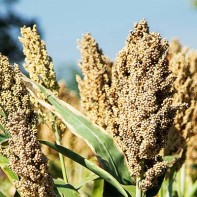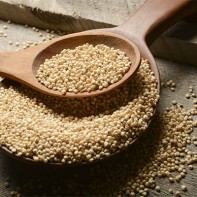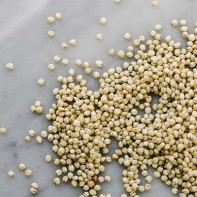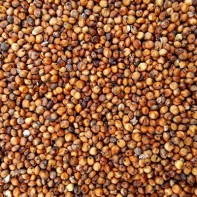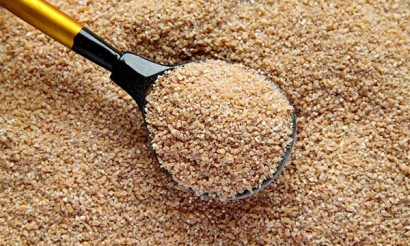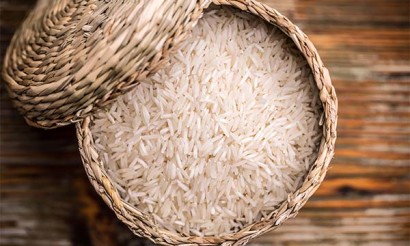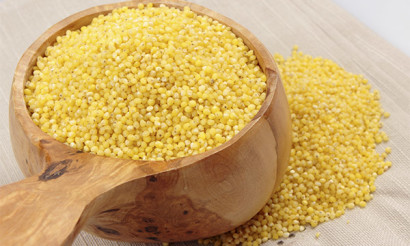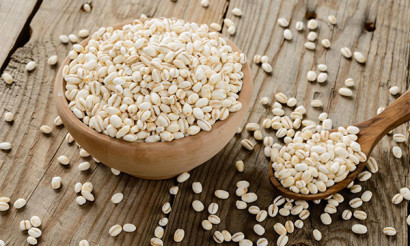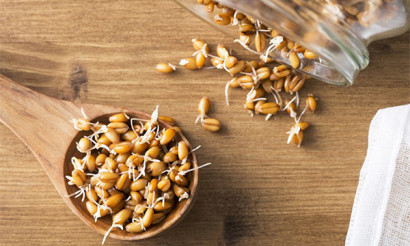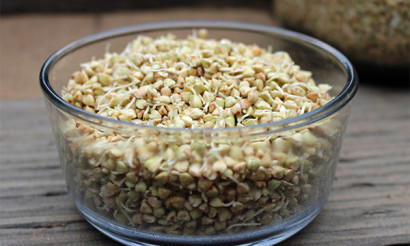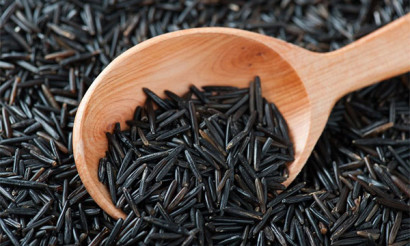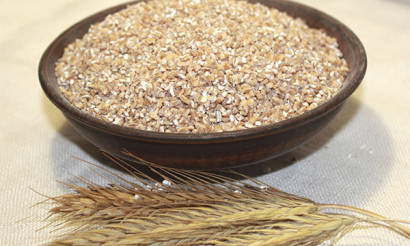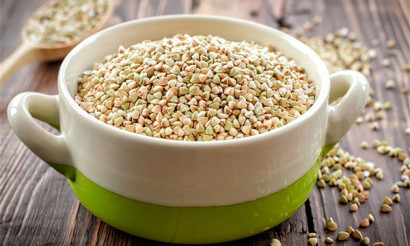Cereals sorghum: useful properties and recipes for cooking
One of the oldest cereal plants that people began to use and cultivate is sorghum. The plant easily tolerates drought, adapts to different soils, is able to suspend its growth under unfavorable conditions, actively developing after the onset of warm sunny weather. In the last century in the Soviet Union sorghum was constantly found on the shelves, but now it can be found more often in health food stores. And at a price it is noticeably higher than the usual cereals.
- What is sorghum?
- Where does the grain crop grow?
- What is the difference between millet and sorghum
- Composition and calories
- What is useful for sorghum grits
- Usage in medicine and cosmetology
- Harms and contraindications
- How to store and where to buy
- How to use sorghum flour
- What can be cooked from sorghum: Recipes
- Salads
- Soups
- Meals
What is sorghum
Sorghum is a herbaceous plant of the bluegrass or cereal genus. There are both annual and perennial species. The multiplicity of varieties and intermediate forms makes it difficult to classify it. Conventionally, we can divide sorghum into several groups based on the use of the plant:
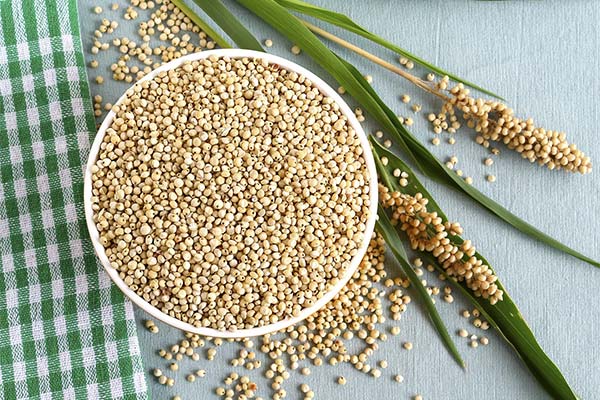
- Grain. This includes Guinea, Kaffir, bread, Negro, Chinese, and other species. Kernels are very similar to millet, varying in color from light to dark brown. It is used for groats and flour. In national cuisines of countries where sorghum grows it is often included in everyday dishes.
- Sugar sorghum. Used for the production of animal feed, molasses, syrup, sorghum honey, biofuel.
- Herbaceous. The most famous cultivated species of this group is Sudan grass, which serves as a feed for livestock and poultry.
- Technical. It is sometimes also called broom because it is used to make brooms, brooms, brushes and paper.
- Lemon. Used as a condiment to dishes, used in the perfume, pharmaceutical, food industry.
Where does the cereal crop grow
In the wild, this crop is found in Asia, Africa, Australia. There is a debate among scientists as to where this cereal first began to grow. Some believe that sorghum was first cultivated in southern Egypt, with China and India as secondary centers of distribution. Others, however, believe that Africa and China were the independent origins of the cultivated varieties.
Although sorghum was not introduced to the Americas until the seventeenth century, the United States is today the largest producer of the grain. It is also grown in Nigeria, Sudan, Mexico, Australia, India, Brazil, China, Argentina and other countries. In the former Soviet Union sorghum is cultivated in Moldova, Kazakhstan, Ukraine and in the south of Russia, but over the past decade the area under sorghum cultivation has declined significantly.
What is the difference between millet and sorghum?
Both plants are cereals. The nutritional value of both are about the same, but millet has more vitamin E, potassium, phosphorus, iodine and cobalt. Whereas sorghum contains more B vitamins, calcium, manganese and iron.
Composition and calories
The nutritional value of sorghum is 323 kcal.
The chemical composition of this cereal makes it one of the most useful among cereals. In 100 grams of the product contains:
Vitamins:
- Thiamine (B1) - 0.46 mg. Necessary for the human body for normal carbohydrate, protein and fat metabolism. Necessary for normal brain function, improves memory, helps concentration. Normalize appetite, beneficial effects on bone and muscle growth.
- Riboflavin (B2) - 0.16 mg. Promotes the formation of red blood cells and antibodies. Helps maintain healthy hair, nails, and improves skin condition. With its lack of a person feels constant fatigue, weakness, loss of appetite. It can cause vision problems.
- Choline (B4) - 93 mg. Prevents the destruction of nerve cells, prevents nervous system disorders. Helps repair damaged liver tissue from the effects of toxic substances. Lowers blood cholesterol levels, reduces the risk of cardiovascular disease. In type 1 diabetes, reduces the need for insulin.
- Pantothenic acid (B5) - 1 mg. Stimulates the production of adrenal hormones. Strengthens the immune system, helps the absorption of other vitamins, slows aging, stimulates normal brain function.
- Pyridoxine (B6) - 0.4 mg. Promotes the digestion of proteins and fats. Prevents nervous disorders. Lack of vitamin causes anemia, seizures, digestive disorders.
- Biotin (B7) - 20 micrograms. Necessary for the recovery of nervous tissue, bone marrow, sweat glands. Has insulin-like activity. Promotes cell growth, so it is especially important for pregnant women.
- Nicotinic acid (B3) - 2.93 mg. It promotes the dilation of small vessels, including in the brain, increases the fibrinolytic activity of the blood, reduces the level of bad cholesterol, is involved in the formation of hemoglobin, the synthesis of hormones. Helps the nervous system function properly.
Macronutrients:
- Potassium - 246 mg. Improves brain function, is necessary for normal skeletal muscle contraction, normalizes heart rhythm, supports the physiological functions of magnesium.
- Calcium - 99 mg. Necessary for strengthening bones and healthy teeth and nails. Prevents acidosis, activates some enzymes and hormones. Accelerates the metabolism, thus burning fat in the human body.
- Silicon - 48 mg. Helps remove toxic substances from human cells, increases the strength of capillaries, bone tissue. Slows the aging of the body.
- Magnesium - 127 mg. Plays a major role in the normal functioning of muscles and nerves. Participates in the conversion of sugar in the blood into energy. Prevents the deposition of calcium. Promotes normal endocrine system activity. Helps eliminate heavy metals from the body.
- Sodium - 28 mg. Activates pancreatic enzymes, is involved in the production of gastric juice, has a vasodilator, and normalizes water-salt metabolism. With a lack of sodium impairs memory, appears dizziness, increased fatigue, muscle weakness.
- Sulfur - 98 mg. Important element in the production of collagen, improves skin, hair, nails. Protects the protoplasm from harmful bacteria, has an anti-allergic effect, promotes blood clotting.
- Phosphorus - 298 mg. Helps keep teeth healthy, necessary for bone growth, improves metabolism, promotes cell division.
- Chlorine - 47 mg. Promotes normal digestion, clears fat from the liver, and removes salts from the body.
Trace elements:
- Aluminum - 1,548 µg. Essential for virtually all reactions in the formation of protein and phosphate compounds. Participates in the regeneration of damaged cells. Supports normal operation of the thyroid gland.
- Boron - 344 micrograms. Prevents the development of diseases of the bone tissue. Participates in the metabolism of calcium, phosphorus and magnesium. Helps to increase vitality.
- Iron - 4.41 mg. Irreplaceable in the formation of hemoglobin in the blood, protects the body from bacteria, necessary for the proper metabolism of B vitamins.
- Cobalt - 2 micrograms. Participates in the synthesis of DNA and amino acids. Necessary for normal metabolism in the body, stimulates the growth of red blood cells.
- Manganese - 2.46 mg. Regulates blood glucose levels, normalizes brain activity, processes in the nervous system. Participates in the production of cholesterol, affects lipid metabolism, prevents the appearance of cholesterol plaques.
- Copper - 390 mcg. Necessary for the conversion of iron to hemoglobin. Participates in the formation of collagen and the synthesis of endorphins.
- Zinc - 2.17 mg. Prevents the development of diabetes, epilepsy, arthritis, rheumatism. Promotes rapid healing of wounds.
Digestible carbohydrates:
- Starch and dextrins - 58 g;
- Mono-and disaccharides (sugars) - 1.6 g.
- Saturated fatty acids - 0.51 g.
- Polyunsaturated fatty acids:
- Omega-3 fatty acids - 0.07 g;
- Omega-6 fatty acids - 1.30 g.
What is useful for sorghum grits
The unique chemical composition makes products from sorghum extremely useful. This grain contains many advantages over other cereals:

- It does not contain gluten. Thanks to the gluten, flour made from wheat, rye, barley is suitable for baking, bread, pasta. However, for some diseases such as celiac disease it is strictly forbidden to eat gluten-containing food. Then sorghum grits can be helpful. It can be used to prepare many delicious dishes to diversify your menu.
- Increased fiber content. Unlike many grains, sorghum has no indigestible shell, so you can cook with whole grains. Not only is it good for the gastrointestinal tract, it is also good for people with diabetes. It has long been seen that foods rich in fiber have a lower glycemic index.
- It contains beta-glucan. It helps reduce cholesterol levels, reduces the risk of cardiovascular disease, increases the beneficial effects of fiber on the human body.
- It is a natural antioxidant. The number of tannins, phenolic acids and phytosterols in sorghum exceeds the number of these substances, even in fruits and berries. It helps to strengthen the immune system, to fight with premature aging of the body, protect it from the harmful effects of the environment. The compound 3-Deoxyanthoxyanin, which is found in large quantities in darker varieties of cereals, counteracts the formation and development of malignant tumors.
- A source of complex carbohydrates. They are more slowly digested, which means they gradually give energy to the body without causing a spike in blood sugar. This is important for people with diabetes. The same for those who adhere to a diet for weight loss, porridge, cooked from sorghum groats, will give a feeling of fullness for a long time. But to get carried away with products from these grains, nevertheless, it is not necessary.
Medical and cosmetic uses
Use sorghum and for medical purposes. Folk healers use not only groats, but also the roots and leaves of the plant.
- In late fall or early spring dig up the rhizome, which sometimes reaches one meter in length. Dry it in a well-ventilated room and take in the form of an infusion for gout, rheumatism and neuralgia. To do this, take 1 teaspoon of crushed dried roots and pour three glasses of boiling water. The container is covered and let stand for about an hour and a half. Take 1 tablespoon 30 minutes before a meal.
- The leaves of the plant are used for poultices during diarrhea. It is enough to put them on the stomach to soon feel relief.
- Infusion from the grain, made as well as from the roots, drink as a diuretic and tonic.
- Include in the diet dishes from sorghum grits doctors advise people exposed to the adverse effects of the external environment, smokers or alcohol abusers. Also, nutritionists recommend it to pregnant women, nursing mothers and people of advanced age.
- In cosmetology, essential oils derived from lemon varieties are most commonly used. It is added to anti-aging creams, tonics, and milks. Grain sorghum is used as scrubs.
Harm and contraindications
For all its usefulness, sorghum should not be eaten by people with individual intolerance to the product. It can manifest itself both in a severe form and in the form of ordinary flatulence.
Dishes made of these cereals are not recommended for people with gastrointestinal tract diseases in the period of exacerbation. In the remission stage, introduce them into the diet with caution, after consultation with the attending physician.
For children, sorghum porridge is given only after five years of age.
How to store and where to buy
Nowadays, it is almost impossible to buy sorghum groats in a regular supermarket. It is worth looking for it where products for healthy eating are sold or in online stores. When buying, you should pay attention to the integrity of the packaging and the shelf life.
At home, sorghum should be poured into a container with a tightly closed lid. In a dry room groats do not lose their useful properties for about two years. Ready bought flour from this cereal should be consumed in food within a year.
How to use sorghum flour
Sorghum flour can be both bought and prepared independently from groats. The most useful will be unrefined, without enrichment.
For baking, it is usually mixed with wheat flour, replacing sorghum flour with about 15-20% of the total amount. If you do not adhere to these rules, the finished product will not bake well, will not be puffy.
Using only gluten-free flour, you need to include a binder ingredient in the dough - corn starch or xanthan gum.
Sorghum flour is also added to sauces for thickening.
What can be cooked from sorghum: recipes
Before you start cooking dishes from sorghum, you need to know that it will take noticeably more time. The grits are boiled for about an hour. Weak own taste of the product can be shaded by spicy herbs or seasonings. Experienced cooks believe that such a garnish, on the contrary, emphasizes the main dish.
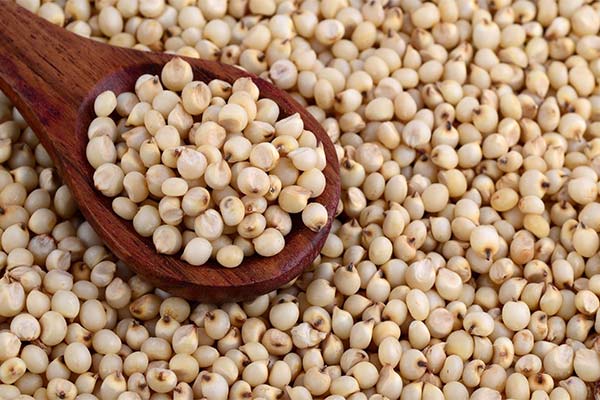
To prepare two portions of crumbly porridge take 150 grams of sorghum and 3 cups of water. Cereals need to be washed in running water, then pour water, salt and cook until the grits are soft. If the porridge was prepared as a separate dish, you can add butter to it.
Salads
Porridge with apples, raisins and carrots
Ingredients: ready crumbly porridge sorghum - 200 grams, an average apple - 2 pieces, raisins - 0.5 cups, an average carrot - 2 pieces, sour cream - 4 tablespoons, lemon juice - 2 teaspoons.
Apples are cut into cubes, carrots - fine julienne. Raisins should be washed in warm water and dried. Add all the components to the porridge and mix.
Salad of vegetables and sorghum porridge
Ingredients: 200 grams of cooked porridge, 3 tomatoes, 2 cucumbers, 0.25 cauliflower, 2 tablespoons of vegetable oil, salt and pepper, herbs.
Wash the vegetables and cut into small slices. Shred the cabbage, rub it with salt to make the juice appear. Mix all the ingredients and leave in a cold place for two hours. Sprinkle with greens before serving.
Nourishing" appetizer
Ingredients: 200 grams of cooked cold crumbly sorghum porridge, 200 grams of green onions, 3 chicken eggs, 1 cup of grated brynza, 1 tablespoon of mayonnaise or sour cream, dill, salt, pepper.
Boil the eggs, cool, peel and cut in half. Chop the onion. Mix porridge with feta, onion and mayonnaise. Then decorate with egg slices and sprinkle with dill.
Soups
Meat borscht with sorghum
Ingredients: 350 grams of pork, 4 tablespoons of boiled sorghum, 1 small beet, 0.25 kale, 2 potato tubers, 3 medium tomatoes, 1 onion, 1 medium carrot, half a root of celery and parsley each, 1 tbsp of 9% vinegar, pepper, salt, bay leaf, herbs.
Wash and dry meat, pour water and put on the fire. After boiling, remove the foam, turn off the gas. While the broth is boiling, wash and shred the beets. Peel the tomatoes, cut into small wedges and stew together with the beets, adding vinegar. Onions and carrots finely chop and fry until the onions turn golden. Peel and dice the potatoes and shred the cabbage. Put the cabbage, potatoes in the ready broth and cook after boiling for a quarter of an hour. Add the beets, boiled sorghum, and the rest of the vegetables. After 8-9 minutes, salt and pepper to taste, put the bay leaf. After turning off the fire, leave the borscht under the lid for about half an hour. Serve, adding a spoonful of sour cream and chopped greens to the plate.
Diet soups with sorghum porridge
Ingredients: 3 tablespoons of cooked sorghum porridge, a bunch of sorrel, a bunch of spinach, 3 potatoes, 1 head of onion, 1 parsley root, 4 chicken eggs, herbs, sour cream, salt, pepper.
Rinse and chop the greens. Chop onion and parsley root and fry in vegetable oil. Boil some water and put potato slices into it. In 15 minutes add onion, parsley, sorghum porridge, greens. Season with salt and pepper. Leave the soup covered for about 15-20 minutes. Together with soup serve sour cream and greens.
Meals
Stewed pork with vegetables and sorghum
Products needed: beef loin - 400 gr, ready-made sorghum porridge - 1.5 cups, bell peppers - 2 pieces, eggplant - 1 piece, medium carrot - 1 piece, fresh tomatoes - 2 pieces, onions - 2 heads, meat broth - 1 liter, wheat flour - 2 tablespoons, garlic - 3 cloves, dill, bay leaf, salt, pepper.
Wash the meat and dry it with paper towel. Cut it into medium-sized cubes and fry it, adding chopped onion and carrot. Wash peppers, remove seeds and stalks, cut them and fry. Eggplant is washed, cut the stalks, cut into small slices, salt and leave for 10-15 minutes. After that, squeeze the juice out of them to get rid of excess bitterness, roll in flour and fry. Peel tomatoes, cut them and fry in vegetable oil. Add meat, vegetables, salt, pepper to taste, pour the broth and stew until tender, stirring occasionally. At the end of cooking, squeeze the garlic into the pan. Sprinkle with dill before serving.
Schnitzel with sorghum porridge
Ingredients: 400 grams of veal, 2 chicken eggs, 0.5 cup of cooked crumbly sorghum porridge, 40 grams of ketchup, 2 heads of onions, 2 cloves of garlic, 0.25 teaspoon of citric acid, 150 grams of tomato paste, 0.5 cup of sour cream, 3 tablespoons of wheat flour, ground pepper, salt, herbs.
Wash and dry meat, finely chop or mince it. Add cooked sorghum porridge, finely chopped onion, raw eggs, citric acid, herbs, salt, pepper, ketchup, squeeze garlic into the stuffing. Mix everything thoroughly, cut into portions and form into schnitzels. Before frying, roll in flour or breadcrumbs. Serve the ready dish with fresh vegetables, sour cream sauce.
«Important: All information on this site is provided solely for informational purposes purposes. Consult with your health care professional before applying any recommendations. professional before using them. Neither the editors nor the authors shall be liable for any possible harm caused by materials."

